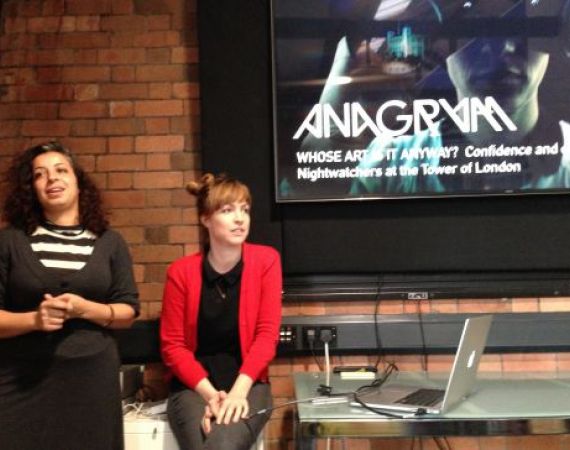Lunchtime talk write-up
Posted on Tue 15 Dec 2015
NIGHTWATCHERS – Designing for the Tower of London
Fresh from making NIGHTWATCHERS, a nocturnal experience at the Tower of London, residents Amy Rose and May Abdalla shared their learnings in a brilliantly subtitled talk ‘Whose art is it anyway? Confidence and Compromise'.

May Abdalla and Amy Rose of Anagram
Posted by
Fresh from the sold out debut of NIGHTWATCHERS, a night time experience at the Tower of London, residents Amy Rose and May Abdalla from Anagram joined us to share what they have learned in a talk they brilliantly subtitled: ‘Whose art is it anyway? Confidence and Compromise’.
Here are five things I learned (as it’s nearly Christmas, these will be shared in the form of Shirley Bassey lyrics):
1) It’s just a little bit of history repeating
In the 1550s, when England withdrew from the the religious authority of Rome, the Tower of London encarcerated several Jesuit priests suspected of treason. It was feared that they were going into exile in Europe, being trained in the art of deception and assassination, and returning to England to kill the Protestant Queen Elizabeth and put a rescued Mary Queen of Scots, her Catholic cousin on the throne. The tower was a tailor made, high security facility to lock away those suspected of the most heinous of crimes – treason against the crown. In NIGHTWATCHERS, Anagram invite you to see this historical context through the lens of growing concerns about terrorism, radicalisation and the idea of foreign training camps in the 21st Century. The connection is never explicitly made, but through the art of subtle storytelling, the past and present rub against one another encouraging critical questioning.
2) The minute you walked in the joint
For Anagram, it was not enough to tell a good story or create a nice piece of theatre. The more they visited the tower, the more they realised that it was, and in many ways still is a real, functioning instrument of the state, much more than a stop on the tourist trail. They discovered that not only do the iconic Beefeaters have a minimum of 22 years military service before the don the costume, but that they live in, and run an army barracks on site which is still a very active military posting.
As they developed the experience, they felt that some part of this it had to not just pretend to be real, but to be, or at the very least to feel real. [Small spoiler alert] Early on in the piece, the persuasive voice on the end of a phone you have been given asks you to plant incriminating evidence on an unsuspecting member of the audience or public, requiring you to prove your mettle in the spy game, and to save your own skin. Having done this myself, I can tell you that my heart went into overdrive. As I chose my victim, sidled up to him and got ready to implicate him in a crime he didn't commit, whilst all the while appearing nonchalant, my basest fight or flight instinct kicked in – it could have gone either way to be honest.
Amy and May explained that bringing an audience to the brink of this heightened state of nervous paranoia bonds you very strongly to what happens next. As you are right in the middle of the action, it matters to you what happens next, and who’s side these people are really on.
3) Golden words he will pour in your ears, but his lies can’t disguise what you fear

May and Amy shared some words of wisdom around commissions that are described as ‘work in progress’. Whilst a commissioner may request some early ideas, ‘just a sketch of what you might do’ or ‘a proof of concept’ and they may have the fullest of intentions of meaning it. In Anagrams experience, it seems that it is always the more elaborated concepts that are actually commissioned, and the client will often start to ask for a level of detail that you would not associate with a ‘work in progress’. Amy and May shared the risk involved in ‘inserting details as they are requested’ in order to keep relationships positive, knowing full well that developing work of this nature is iterative and emergent. At some point you have to come clean and say that those early prized details aren’t true or appropriate anymore. They recommend instead trying to bring commissioners with you on that development cycle if at all possible.
4) I who have nothing
User testing is a gruelling but crucial part of Anagram's process. Before launching to the public in November, Amy and May had tested endless permutations of the work with around 100 people from a wide range of backgrounds to see what made sense to them, what they responded to and what didn’t work as they had imagined. Amy talked about the benefits of striping away layers, taking out elements when they are not needed, and working out; How much (little) is enough to get it just right. This can be pretty harrowing as a maker, and can leave you with the feeling is that it will be basically terrible until the very last minute when you hit that sweet spot and it all comes together.
5) Honestly is the best policy – ok that might be more my mum than the great Dame herself but I suspect her Shirleyness would agree.
It was a pleasure to hear a candid and generous insight from some of the most exciting people making work anywhere right now. The fifth thing I have learned, or perhaps have re-learned, is that it is extremely valuable to share what you discover, warts and all. Since the talk, lots of people have been telling me how much they can relate Amy and May’s triumphs and tribulations to their own practice, and how good it is to hear how other people tackle compromise and adversary, as well as all the good stuff. So thanks Amy and May, I’m inspired. And now I’m off to don a sequinned frock, poof up my hair and belt out some earth-shatteringly open and honest power ballads, I don't pop my cork for rum tee tum tee tum...
